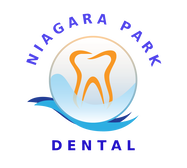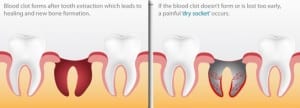|
Dry socket (also called alveolar osteitis) is an extremely painful dental condition that can occur after removal (extraction) of a permanent adult tooth. Having a tooth removed is generally not something anyone looks forward to. Most people understand there will be some level of discomfort following the procedure. Many are given a prescription for pain medication before leaving their dentist. Most people in fact do not even need to get the prescription filled. However, when a patient experiences what is called a dry socket the pain can become quite intense and linger for days. Very few people are affected by dry socket. The development of Dry socket after a tooth extraction occurs in only about 2-3% of patients. For those who experience dry socket it can be a very scary experience. Fortunately dry socket is treatable. A dry socket occurs when the blood clot at the site of the tooth extraction has never fully formed, has broken free, or has dissolved before the wound has had a chance to fully heal. The blood clot is the protective layer for the underlying bone and nerves, it begins the process of healing so that gum tissue and bone can refill the area. When the clot is gone the bone and nerves are now exposed to the outside air, food, fluid, and anything else that enters the mouth. This can lead to a dry socket with sharp, aching pain that can last for 5-6 days, and in the case of a patient taking fosamax type drugs the pain can last for weeks. A dry socket is considered the most common complication following tooth extractions. It happens more frequently with extraction of impacted wisdom teeth, in patients with poor blood flow to the socket, (smokers, patients taking fosamax), delayed healing (diabetics ). The pain begins to build and develop about 2-4 days following the procedure. Signs and Symptoms of Dry SocketSigns and symptoms of dry socket may include: -Sharp, aching pain within 2-4 days after a tooth removal. -Partial or total loss of the blood clot at the tooth extraction site. You would be able to visually notice a deep hole or space where tooth used to be, that weeps fluid when pressed vs a blood clot overlaying the site. -Bone that is visible upon visual examination in the socket -Pain that radiates from the socket to your ear, eye, temple or neck on the same side of your face as the extraction -Abnormally bad breath or a foul odour emanating from your mouth. This will coincide with having a bad taste in your mouth as well. -If you have swollen lymph nodes around your jaw or neck, this is a sign of infection and you need to be seen by your dentist immediately. Over the counter medications by themselves will not control the symptoms. We will need to begin treatments to lessen pain and allow for healing to take place. Treatment of Dry SocketTaking a nonsteroidal anti inflammatory drug (like ibuprofen) can help to ease the pain but probably will not be enough to take it away completely. When the pain persists you should call us immediately. We may prescribe you a stronger pain medication to allow the pain to subside for you or give you anesthesia in the office to relieve some of the symptoms for a little while anyway. Paste for Dry Socket What will we need to do for the dry socket? we will need to numb and clean the tooth socket. This will allow for removal of any debris from the space where the tooth once was, and allow for rebleeding into the site. We may then fill the socket with a medicated dressing or a special paste to promote healing and soothe the symptoms. The dressing may need to be reapplied if pain persists after three days. Warm cloth on the outside of the face also helps promote blood flow. An antibiotic may also be prescribed at this point to prevent an infection from forming. At home care will include rinsing with salt water and being careful what you eat and how you eat it, ( avoiding the side where the dry socket is ). The site will usually heal completely following treatment in 1-2 weeks. Who is most likely to get a Dry Socket?Some patients will be more likely than others to get a dry socket after a tooth extraction. These include the following:
–Smokers. Patients who smoke have twice the chance of developing dry socket over those who do not. smoking also is believed to slow the healing process. –Poor oral hygiene. Those with poor oral hygiene will have an increased risk due to the amount of bacteria in the mouth. Will be difficult to maintain a sterile field when removing tooth. –Having wisdom teeth (3rd molars) extracted. Increased trauma to area during procedure is one of the indicators for increasing the possibility for the development of dry socket. 3rd molars tend to be more difficult to remove especially if they are fully or partially impacted. –Previous history of dry socket. If you have had dry socket previously, you are more likely to develop it after another extraction. –Use of birth control pills. Contraceptives which contain estrogen effect the blood clotting system of the body. So we see an increased incidence in dry socket in patients on oral contraceptives. Rinsing and spitting a lot or smoking after having a tooth extracted also can increase your risk of getting dry socket. These activities will increase chances of the blood clot becoming dislodged. Following the removal of a tooth, it is very important to follow all instructions given to you. If you are unsure of anything you must ask or call back. At first sign of pain or discomfort call your dentist to be sure it is not something more serious. As always, maintain a regular schedule visiting your dentist, as well as keeping an open communication with your dentist. This will make you feel comfortable asking questions and knowing you are getting the proper information to care for your oral health.
0 Comments
Your comment will be posted after it is approved.
Leave a Reply. |
AuthorArticles are written by Dr M Hajarat. Archives
July 2024
|
|
Niagara Park Dental
3 / 16 Washington Avenue Niagara Park, NSW 2250 Email: [email protected] Phone: (02) 4329 3003 |
HOURS
Mon 9:00 - 5:30 Tue 9:00 - 5:30 Wed 9:00 - 5:30 Thu 9:00 - 5:30 Fri 9:00 - 5:30 |
|






